Ferrari and Aeronautica Militare: the Prancing Horse at Mugello for F1. On Sunday 13 September, before the Formula 1 Grand Prix at Mugello, an Italian Air Force Eurofighter formation will fly over the pit lane. On the tail the prancing horse that links the branch of the Italian Army to Ferrari. Andrea Tartaglia. 12 September – Milan.
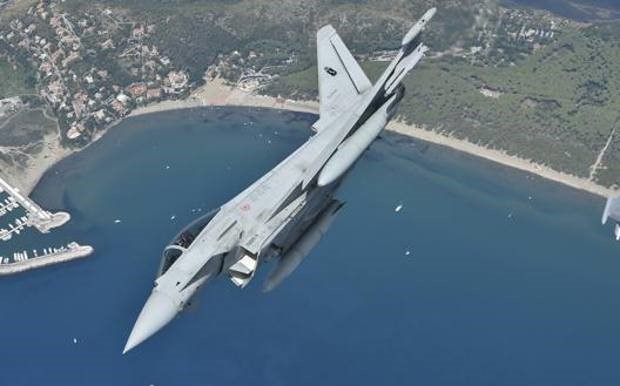
A Eurofighter of Italian Air Force (Aeronautica Militare Italiana).
The bond that unites Ferrari and the Italian Air Force has its roots in a history made up of men who were able to intuit the potential of the future that was opening up before them. Indeed, they knew how to write that future, united by a symbol: the prancing horse. Two men in particular: Major Francesco Baracca, ace of Italian aviation and Enzo Ferrari. To celebrate this bond, on the occasion of the Ferrari 1000th Grand Prix in Tuscany on Sunday 13 September, a Eurofighter formation will open the event flying over the Mugello circuit. The Air Force fighters, which daily ensure the defense of national and NATO airspace, will have the prancing horse painted on the fuselage, just like Baracca's Spad S.XIII. In particular, these are Eurofighter interceptor fighters belonging to the 9th Flight Group of the 4° Flock of Grosseto and to the 10th and 12th Flight Group of the 36° Flock of Gioia del Colle (Ba).
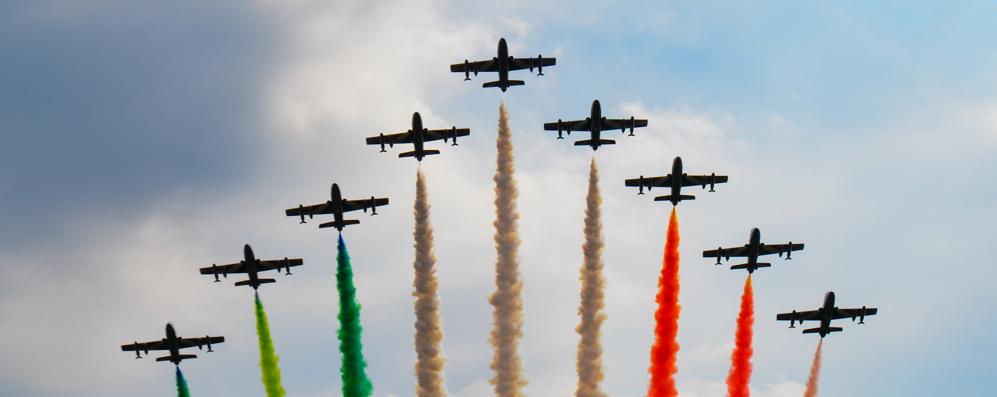
Monza GP 2020, Frecce Tricolori.
A link, that between air and track, which is renewed: last September 6, in fact, the MB-339 Pan aircrafts of the Frecce Tricolori waved the Tricolor on the 2020 Italian Grand Prix in Monza, just before the start of the race.
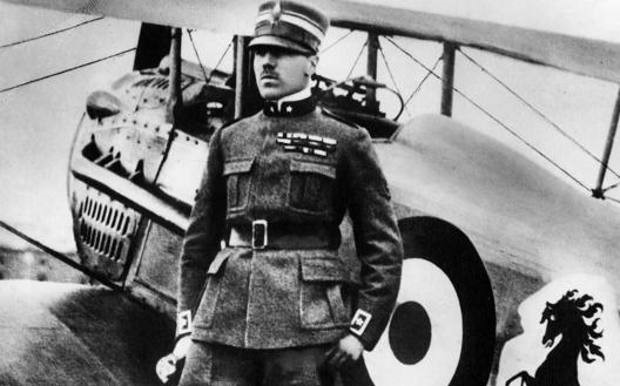
Major Francesco Baracca and the prancing horse painted on his plane.
Why the prancing horse on the planes of the Blue Army? We need to go back over a hundred years and tell the story of Major Baracca, his victories and his early death on Montello at only thirty years old. Born in 1888 in Lugo (Ra), son of Enrico - a businessman - and of the Countess Paolina de Biancoli, he entered the Royal Army in 1907. The prancing horse - silvery color on a red field, facing left and with the tail lowered - was the heraldic emblem of the "Piemonte Reale Cavalleria", one of the most prestigious units of the Italian Army, where Francesco Baracca served. Shortly thereafter, Baracca wanted to become an aviator, his love for horses subsequently led him to choose to adopt, with some variations, the same emblem as a symbol for his airplanes, as was the custom for the aviators of the time.
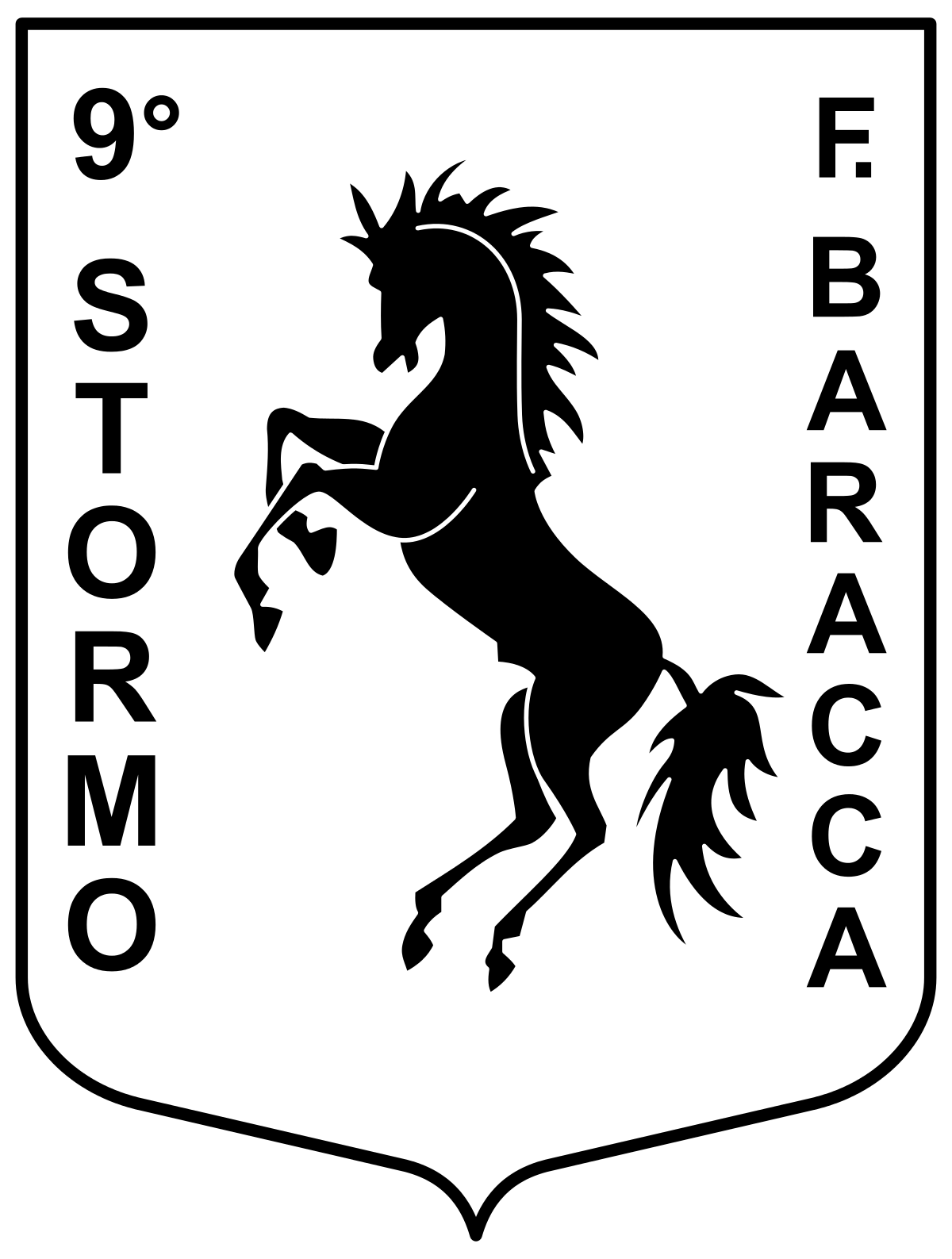
Ensign of the 9º Flock of the Italian Air Force.
The black prancing horse appeared for the first time on an airplane piloted by the Ace at the beginning of 1917 and definitively became the insignia applied to the fuselage of the aircraft he piloted within the newly formed 91st Squadron. On 19 June 1918 Francesco Baracca was shot down on Montello, near Nevesa della Battaglia, presumably by an Austro-Hungarian biplane, but the body of the pilot and the remains of the plane were found only on the 23. In 63 aerial fights he had achieved 34 victories, often the opponents survived the shot down because - as the Ace explained - “it is at the plane that I aim, not at the man”. And, as chivalrous custom, Baracca used to shake their hand.
That time when Gilles Villeneuve challenged a fighter with a Ferrari. Gazzetta Motori: all the news. The Canadian of Ferrari was the protagonist of the thrilling duel that saw him beat the F-104 jet of the Italian Air Force with his F1 car in an acceleration race. Manuele Cecconi, November 24, Milan.

Gilles Villeneuve and his Ferrari F1.
It was one of the most exciting challenges in the entire history of engines, so much so that after 38 years it is still celebrated by fans of Formula 1 and aviation: we obviously refer to the mythical confrontation between Gilles Villeneuve and the F-104 Starfighter, that took place at the Istrana airport on November 21st 1981. On the anniversary of that epic battle, the Air Force also wanted to remember that day, posting on its social profiles the video of the unforgettable duel between the red 126 Ck and the very fast jet.
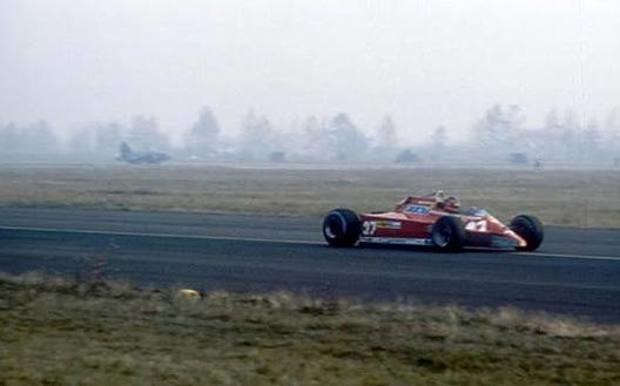
Red win: the 126 Ck's six-cylinder turbo defeated the F-104's powerful J79 turbojet.
Despite the unfavorable climate, the public was that of great occasions: it is estimated that that day in Istrana (Treviso) there were between eighty thousand and one hundred thousand people, including the new 500 cc champion Marco Lucchinelli. Among the Formula 1 drivers who would have challenged the F-104S of the 51st Flock there were also Nelson Piquet and Riccardo Patrese with the Brabham and Bruno Giacomelli with the Alfa Romeo, but almost all those present were there for Gilles Villeneuve and his Ferrari 126 Ck, the Prancing Horse's first turbo F1. During the acceleration race, organized with the approval of the Ministry of Defense, the Canadian ace would challenge on the control of the "Red” the bisonic jet piloted by Lieutenant Daniele Martinelli.
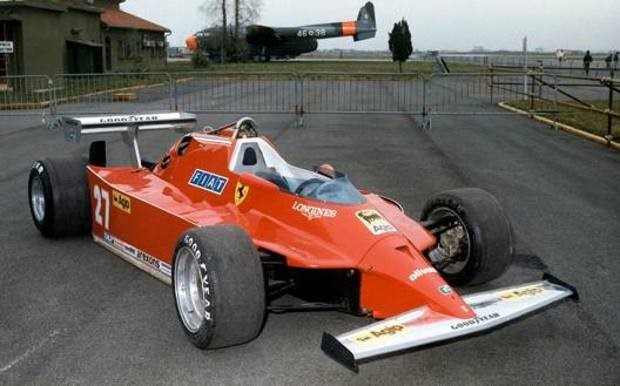
The 126 C was the first Prancing Horse single-seater to be fitted with a turbocharged engine.
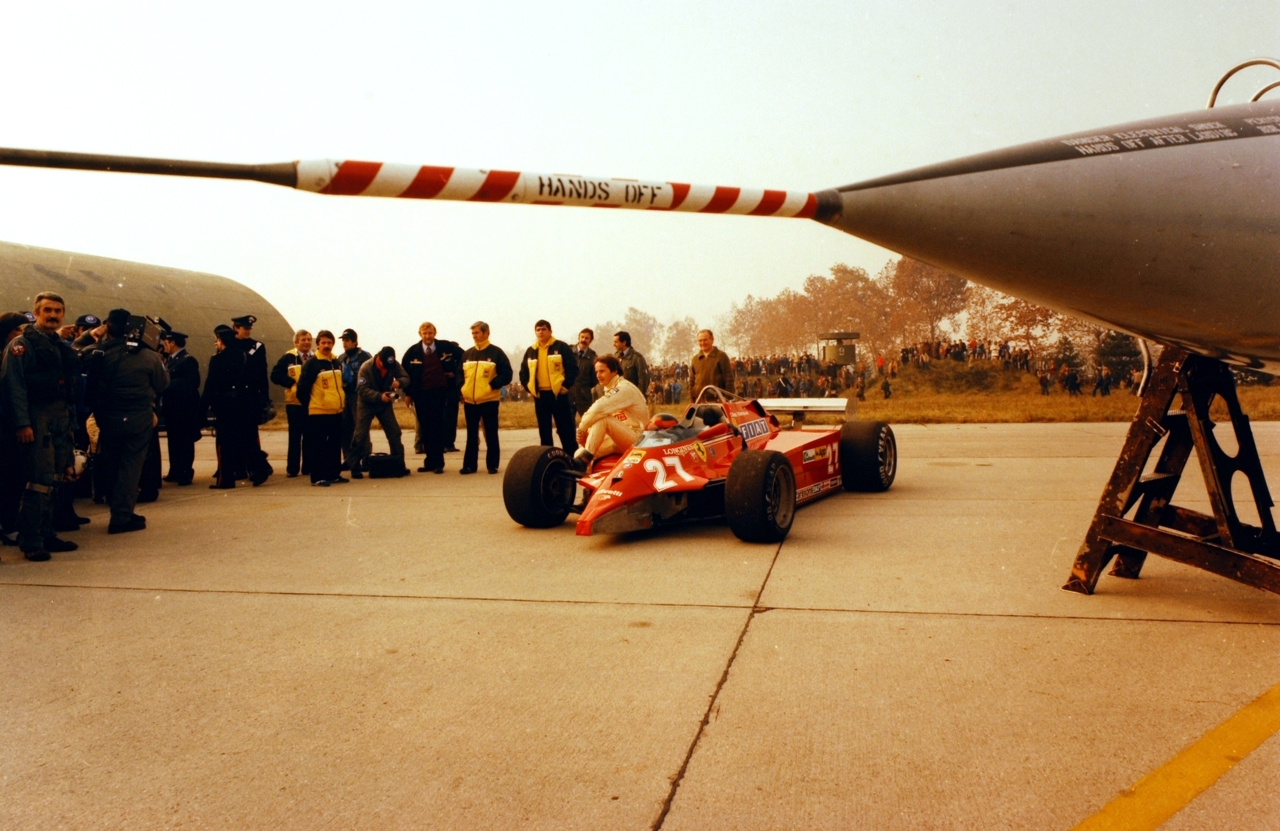
The opponent was formidable: the “Spillone" (Pin) (term with which the F-104 was affectionately nicknamed due to its tapered shape) was a single-engine fighter designed by Lockheed and later produced under license also by Fiat-Aeritalia in its S version. Equipped with a 79.6 kN thrust General Electric J79 turbojet, the Starfighter was capable of a maximum speed of mach 2.2 (2.330 km/h, over twice the speed of sound). Mainly conceived as an interceptor but also used in the roles of reconnaissance, fighter-bomber and even nuclear bomber, the 104 represented the backbone of the Air Force from the 1960s until its radiation, which occurred only in 2004.
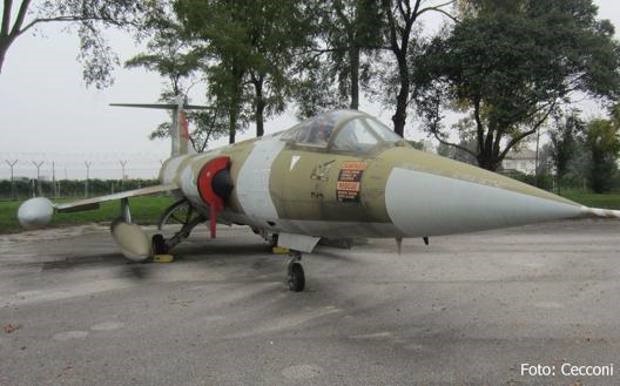
The 'winged' protagonist of the challenge was an F-104 of the Italian Air Force, an interceptor fighter capable of a speed of Mach 2.2.
In short distances, Ferrari's standing start would undoubtedly have delivered victory to four wheels, while on a longer track the powerful J79 of the F-104 would have easily annihilated the piston competition of the V6 turbo from Maranello. To keep the challenge uncertain, a compromise was opted for, a distance slightly higher than a kilometer which the Starfighter would have to cover without removing the wheels from the ground and without resorting to the afterburner. A significant disadvantage, which did not allow the fighter to use all the power and required its pilot to reduce the 'throttle' in order not to risk taking off prematurely (only after the finish the planes could have taken off). The thick fog that descended on the Treviso area also forced military pilots to take on much more fuel than necessary, as the probability of having to land on another airport was quite high.
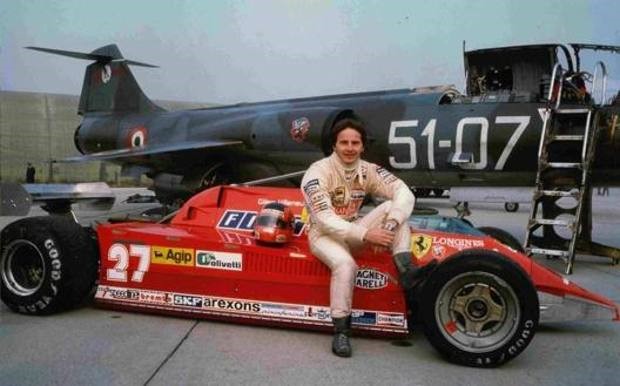
Villeneuve posing on his Ferrari in front of the F-104, on November 21st, 1981.
Gilles and Ferrari wanted to win that challenge at all costs: to minimize aerodynamic drag, the men of the “Cavallino” removed the ailerons of the 126 Ck, which in the absence of curves could thus fully express its speed performances. In the end it was the single-seater that excelled: doing a time of just over 16 seconds Villeneuve managed to beat the jet fighter, which was slower by about 3.5 seconds. Acclaimed by the crowd, Gilles even had to disguise himself as an AMI officer to be able to escape from the multitude of delirious fans in a jeep.
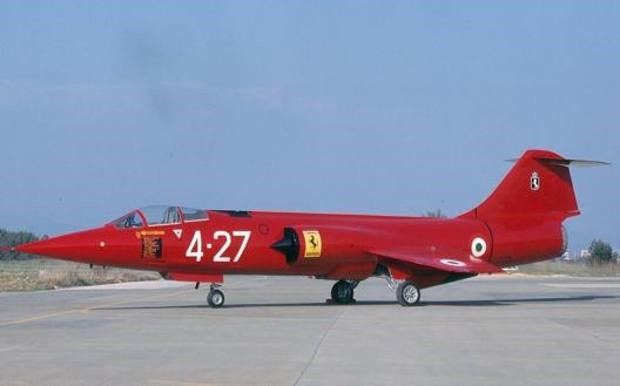
The celebratory Starfighter donated by AMI to Ferrari: on the fuselage the banner of the Maranello company, on the tail the Prancing Horse of the 4th Flock.
A few years later, in 1989, the Blue Army wanted to pay homage to the Maranello firm by giving it a 104 in Ferrari red livery. The identification number shown on the fuselage of the aircraft, which is still visible at the Fiorano circuit, is 4-27: if the 4 recalls the 4th Flock (formation that adopts Francesco Baracca's prancing horse as a symbol, later taken up by Enzo Ferrari for his cars) the 27 obviously refers to the race number of the late Canadian driver, who died a few months after the legendary challenge in the terrible accident of Zolder '82. The plane is now on display inside the Fiorano racetrack, owned by Ferrari. The conditions of the aircraft - stored outdoors a few meters from the track without any protection - are to be considered precarious. In many parts the red no longer exists, "corroded" by rain, sun and smog. What a pity!
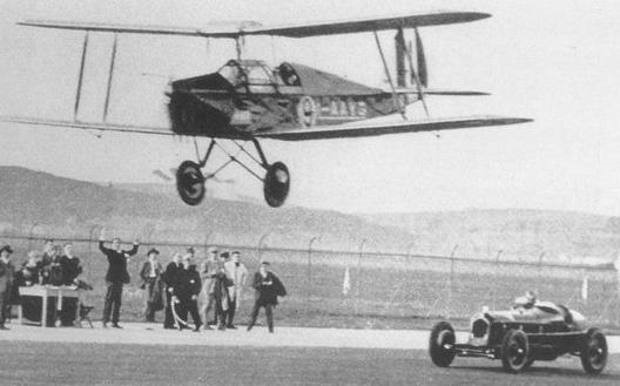
Nuvolari lost the challenge with the Caproni biplane, but fifty years later Villeneuve would have 'avenged' him.
Many years earlier another motoring champion had tried, unsuccessfully, to challenge an airplane: on November 8, 1931, Tazio Nuvolari and his Alfa Romeo 2300 were confronted with a Caproni propeller biplane. The Flying Mantuan lost the duel, but exactly fifty years later he would have been avenged by a certain Canadian driver...
When Schumi in Ferrari challenged a fighter 16 years ago: this is how it went. Gazzetta Motori: all the news. On 11 December 2003 Michael Schumacher faced a Eurofighter Typhoon fighter aboard his F2003GA. Manuele Cecconi, December 11, Milan.
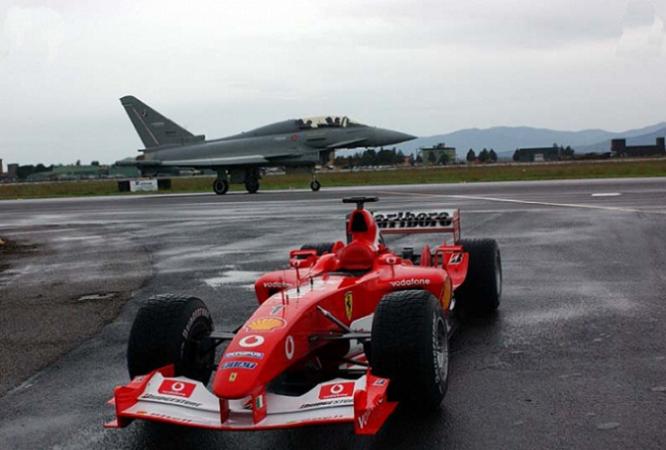
Ferrari versus Eurofighter, 2003.
The charm of the challenge, the adrenaline of maximum speed confrontation: the one between the car and the airplane is a duel that has been repeated several times in the history of engines, especially in a country like Italy where the passion for four wheels and that for flying have generated excellences that represent the Bel Paese all over the world. More than two decades after the epic acceleration race between Gilles Villeneuve's Ferrari and an Air Force F-104 Starfighter, Michael Schumacher was also the protagonist of a battle against a military fighter: on 11 December 2003, exactly 16 years ago, the Kaiser challenged an Ami Typhoon Eurofighter aboard his Formula 1 Ferrari.
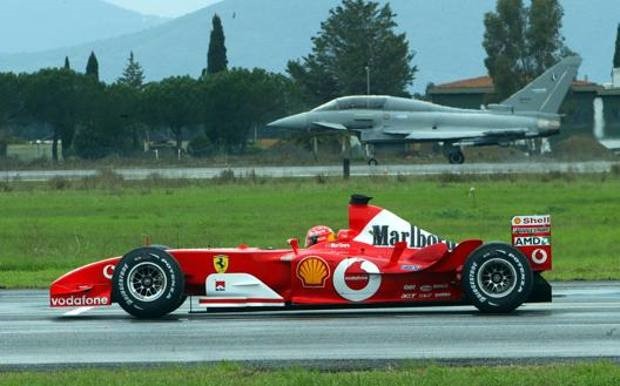
Red light before the start. Ap.
It happened at the "Corrado Baccarini" Airport of Grosseto, home to that 4th Flock which has as its symbol that Prancing Horse that Francesco Baracca's family gave to Enzo Ferrari as the emblem of his racing cars. The challenge consisted of three races on different lengths, to "equalize" the values in the field as much as possible and avoid favoritisms: Schumi, fresh winner of his sixth world title in Formula 1, would try on board the F2003GA to beat a Typhoon Eurofighter, supersonic jet that in those years was preparing to replace the F-104 in the role of interceptor fighter of the Blue Army. At the controls of the aircraft was none other than Maurizio Cheli, test pilot of Alenia Aeronautica on the Eurofighter and astronaut who has accumulated to date 370 hours of space activity.
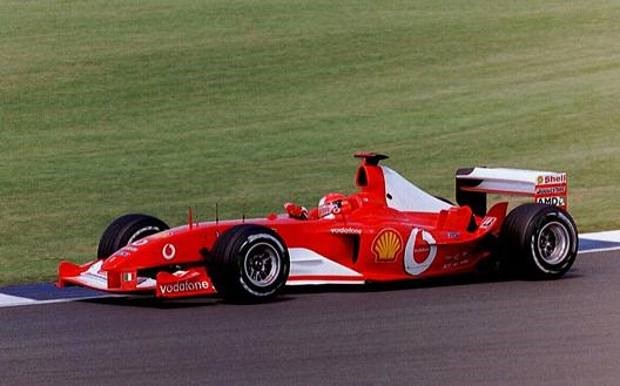
Equipped with a 3-liter V10 engine, the F2003GA won 8 of the 16 Grand Prix of the 2003 season.
Named after Gianni Agnelli - who passed away on January 24, 2003, shortly before the presentation of the car - the F2003GA had just given Ferrari its fourth Schumacher-era drivers' title, also winning the Constructors' World Championship thanks to eight victories out of sixteen Grand Prix disputed (six by the German plus two by Rubens Barrichello). Powered by a 2,997 cc 10-cylinder V engine, the Cavallino single-seater could count on about 900 horsepower at 19,000 rpms, power enough to make it exceed 350 km/h in the most “unloaded” aerodynamic configuration.

The two vehicles in full acceleration (Ansa).
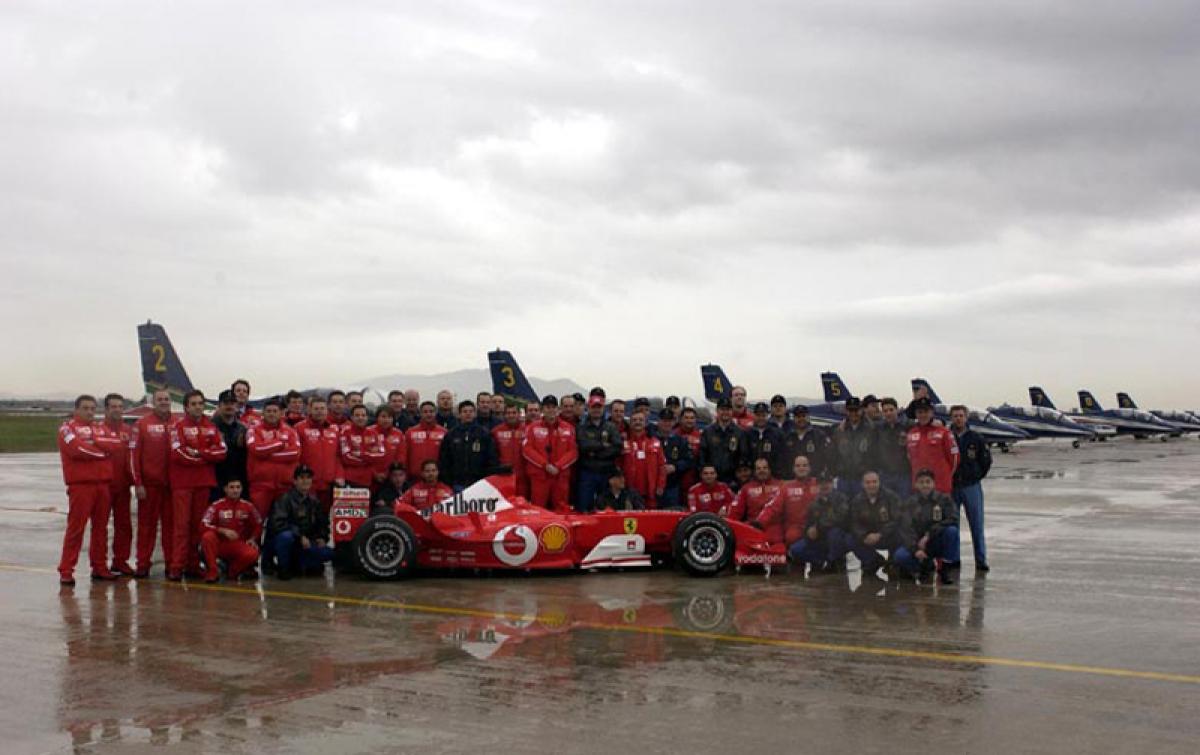
Called Efa (European Fighter Aircraft) in the prototype phase and then F-2000 in the official designation of the Air Force, the Typhoon Eurofighter is one of the most advanced fighter aircrafts currently in service: the project of this lethal interceptor fighter, flagship of the European aviation industry, has seen the collaboration of the major companies in the sector from countries such as the United Kingdom, Germany, Italy and Spain. Having joined the AMI flight line in the mid-2000s, the Typhoon is currently the backbone of the Italian air defense and also serves in the Air Forces of third countries such as Austria, Saudi Arabia and Kuwait: powered by two Eurojet turbofans EJ200, this extraordinary multirole can reach Mach 2 with a top speed of almost 2,500 km/h.
Ferrari Cavalcade visits the 9th Flock "Francesco Baracca" of Grazzanise. Gazzetta Motori: the 2019 Ferrari Cavalcade stopped off at Grazzanise Airport to visit the 9th Flock "Francesco Baracca". Stefano Bellotto, 21 June - Milan.
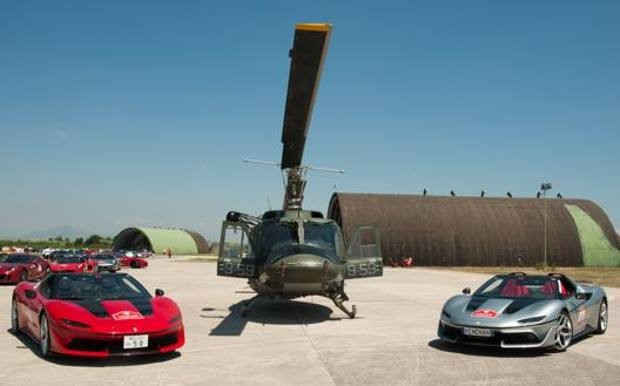
GRAZZANISE – The Ferrari Cavalcade 2019, a traveling event organized by the Maranello company for its most loyal customers, made a stop in recent days at the military airport of Grazzanise, in the province of Caserta. The "reds" visited the 9th Flock of the Air Force, a prestigious unit of the Blue Army equipped with HH212/A helicopters to support special operations: over 200 Ferraris from Europe, United States, New Zealand, Australia, Middle and Far East, were able to visit the base and travel the runways; the cleverer owners have even indulged in the whim of doing some drifting between the helicopters...
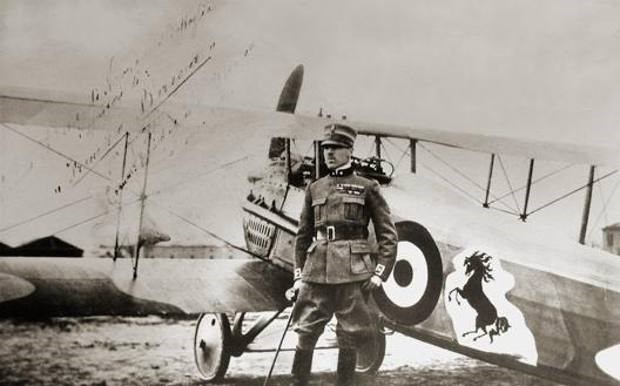
After Baracca's death and the First World War ended, the mother of the pilot from Lugo gave Enzo Ferrari the emblem that his son had painted on the cockpit of his fighter: the Drake revisited it in his own way, changing the color of the background and the position of the tail before making it debut on his Alfa Romeos at the 24 Hours of Spa in 1932. Even today the symbol of the Prancing Horse, which became a legend thanks to Ferrari, still makes its appearance in the signs of various departments of our Air Force: in addition to the 9° Flock it is also adopted by the 4° Flock and the X and XII Flight Group of the 36° Flock.
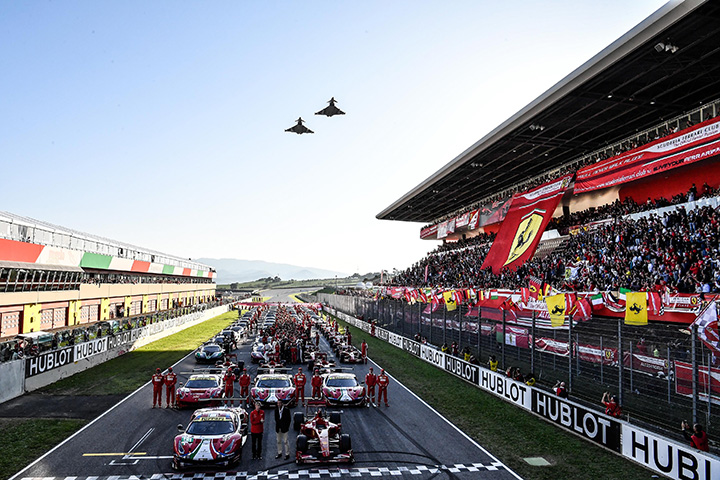
Finali mondiali, Mugello 2019. Ferrari-show.
Formula 1, Tuscan GP Ferrari 1000: Eurofighter fighters of the Italian Air Force fly over Mugello. 12 September 2020.
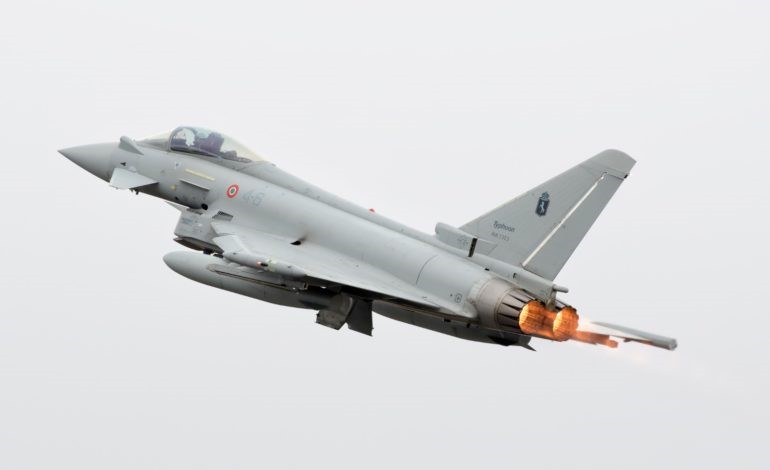
To celebrate the 1000th Grand Prix of the Ferrari team in Formula 1, on Sunday 13 September the Air Force will open the Tuscan GP Ferrari 1000 with the flyover of a Eurofighter fighter formation which, just like the SPAD S.XIII of Baracca, report on the fuselage the prancing horse, a symbol that still today characterizes the flight departments of the Armed Forces that ensure the defense of national and NATO airspace on a daily basis. In particular, these are Eurofighter interceptor fighters belonging to the 9th Flight Group of the 4th Flock of Grosseto and to the 10th and 12th Flight Group of the 36th Flock of Gioia del Colle (BA).
"I still retain the photograph of Baracca, with the dedication from the parents by which they entrust me with the emblem" - wrote Enzo Ferrari on July 3, 1985 to the historian from Lugo Giovanni Manzoni - "The horse was and has remained black; I added the canary yellow background which is the color of Modena”. The Prancing Horse returned to appear as the emblem of the 91st in the 1920s, to then receive a definitive consecration as the insignia of the 4th Flock of the Regia Aeronautica at the behest of Amedeo d’Aosta who commanded it at the time. The same emblem was also used for a period on Ducati motorcycles, at the request of the then designer Fabio Taglioni, a native of Lugo di Romagna. The prancing horse still flies on the tail rudder of the Eurofighters of the Italian Air Force and, as is well known, races on the cars of Maranello.
Videos
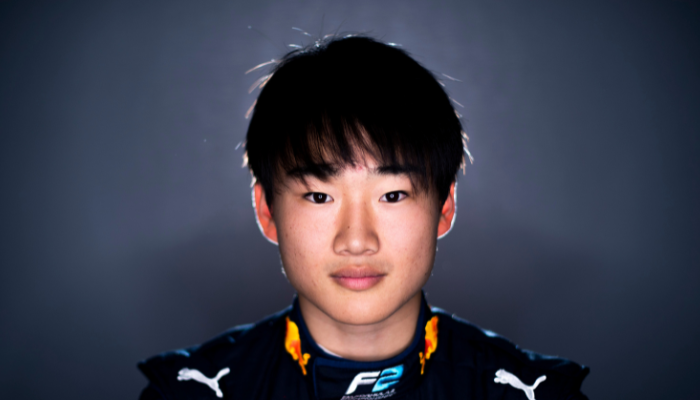
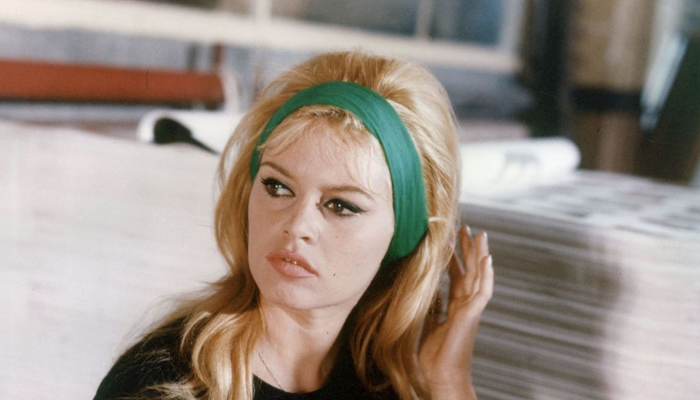
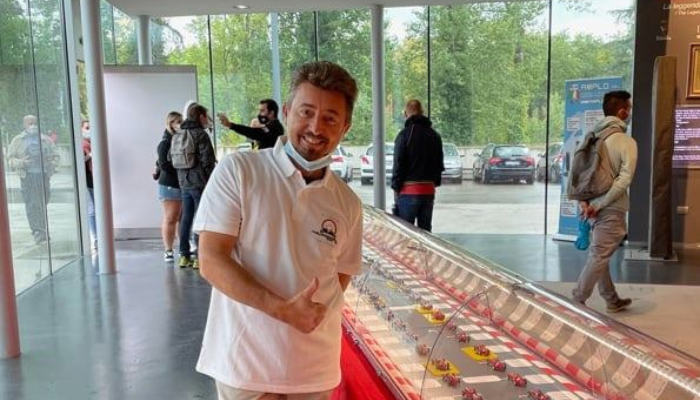
Comments
Authorize to comment